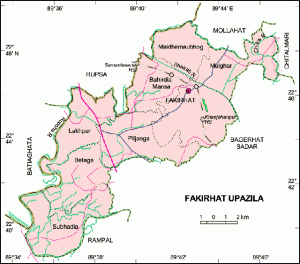Geography
Fakirhat is located at 22°46′50″N 89°42′30″E / 22.7806°N 89.7083°E / 22.7806; 89.7083 . It has 24286 units of house hold and total area 160.68 km².

Demographics
As of the 1991 Bangladesh census, Fakirhat has a population of 123956. Males constitute are 51.12% of the population, and females 48.88%. This Upazila’s eighteen up population is 67565. Fakirhat has an average literacy rate of 43% (7+ years), and the national average of 32.4% literate.
Administrative
Administration Fakirhat thana was established in 1869 and was turned into an upazila in 1983. It consists of 8 union parishads, 67 mouzas, 87 villages.
Archaeological Heritage
Shiva Mandhir and Khanjahania Mosque.
Historical Events
During the War of Liberation in the Razakars made a surprise attack on the camp of the freedom fighters at village Deyapara of Shuvadia Union in which many people of both sides were killed and wounded. Marks of War of Liberation Memorial monument 3, memorial sculpture 1.
Religious Institutions
Mosque 170, temple 66, sacred place 1, most noted of which are Khanjahania Mosque, Dohazaree Shiva Mandhir, Manasabari Kalibari.
Population
Total Population 123956; male 51.12% and female 48.87%; Muslim 71.55%, Hindu 28.43% and others 0.02%.
Literacy and Educational Institutions
Average literacy 43%; male 49% and female 36.7%. Educational institutions: college 3, technical college 1, non-government high school 24, government high school 2, madrasa 27, government primary school 53 and non-government primary school 20. Noted institutions: Mulghar Government High School (1857), Bahirdia High School (1892).
Cultural Organizations
Cinema hall 1, theatre group 5, women’s organisation 30 and rural club 25.
Main Occupations
Agriculture 38.15%, fishing 2.81%, agricultural labourer 16.94%, wage labourer 6.07%, commerce 14.86%, transport 3.01%, service 8.3%, others 9.86%.
Land Use
Arable land 10072.03 hectares, fallow land 5804.53 hectares; single crop 64%, double crop 30% and treble land 6%.
Land Control
Among the peasants 33% are marginal, 35% small, 25% intermediary and 7% rich.
Value of Land
Market Value of the first grade of land Tk. 6000 per 0.01 hectare.
Main Crops
Paddy, potato, betel leaf and vegetables.
Extinct and Nearly Extinct Crops
Mustard seed, sweet potato and pulses.
Main Fruits
Coconut, boroi, betel nut and banana.
Livestock and Fisheries
Fisheries, dairies and poultries Fishery 7463, dairy 33, poultry 47.
Communication Facilities
Roads: pucca 61 km, semi pucca 10 km and mud road 563; waterways 30 nautical mile; railways 10 km; railway station 3.
Traditional Transport
Bullock cart and palanquin. These means of transport are extinct or nearly extinct.
Mill & Factory
Manufactories Ice factory 1, oil mill 10, rice mill 20, frozen shrimp preservation 2.
Cottage Industries
Bamboo work 85, goldsmith 52, blacksmith 65, wood work 136, potteries 30, tailoring 125 and kantha sewing 15.
Hat Bazaar
Hats, bazars and fairs Hats and bazars are 17; fairs 6, most noted of which are Fakirhat, Lakhpur hat and Atraka Baishakhi Fair.
Main Exports
Coconut, betel leaf, shrimp, and betel nut.
NGO Activities
Sukhee Manush, Drishtanto, Prodipon, Prisam, Viko Bangladesh, Nabolok, asa, brac, grameen bank and CARE.
Health Centers
Upazila health complex 1, family planning center 8, satellite clinic 1 and community clinic 7.
 Bagerhat Info Largest Bagerhat Online Portal for Latest News, Blog, Informations & Many More
Bagerhat Info Largest Bagerhat Online Portal for Latest News, Blog, Informations & Many More